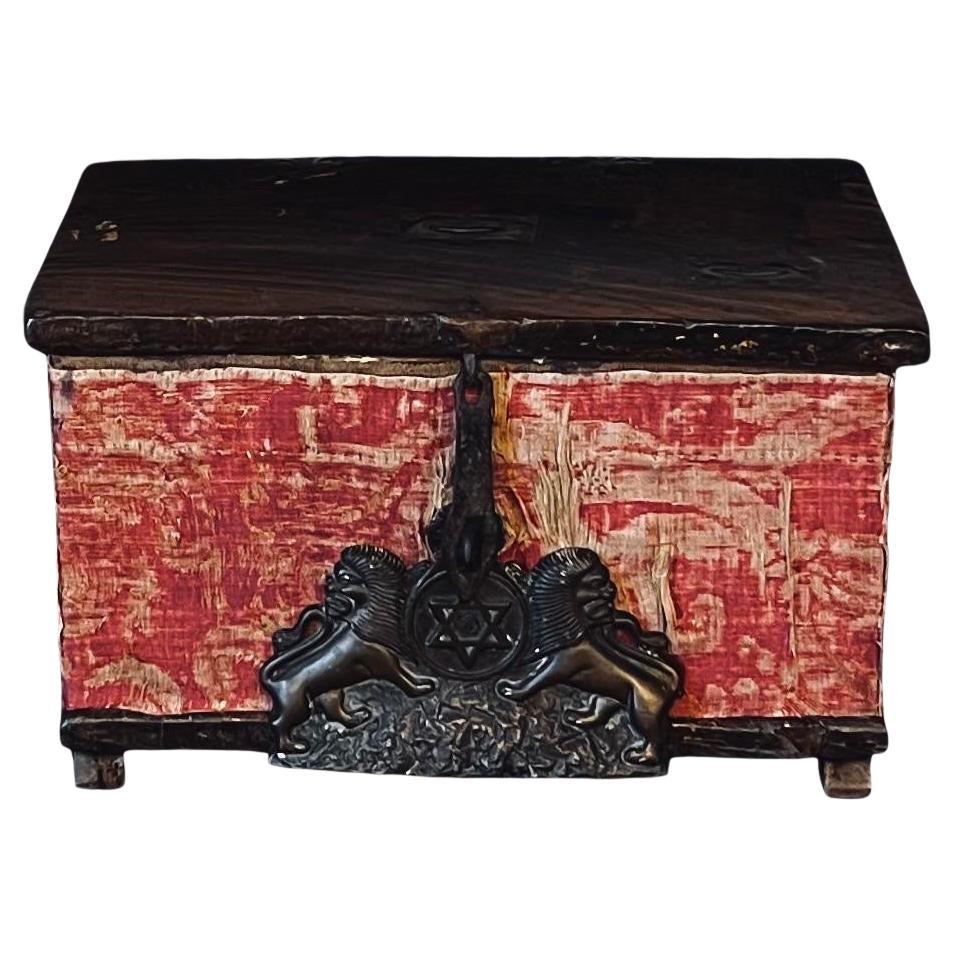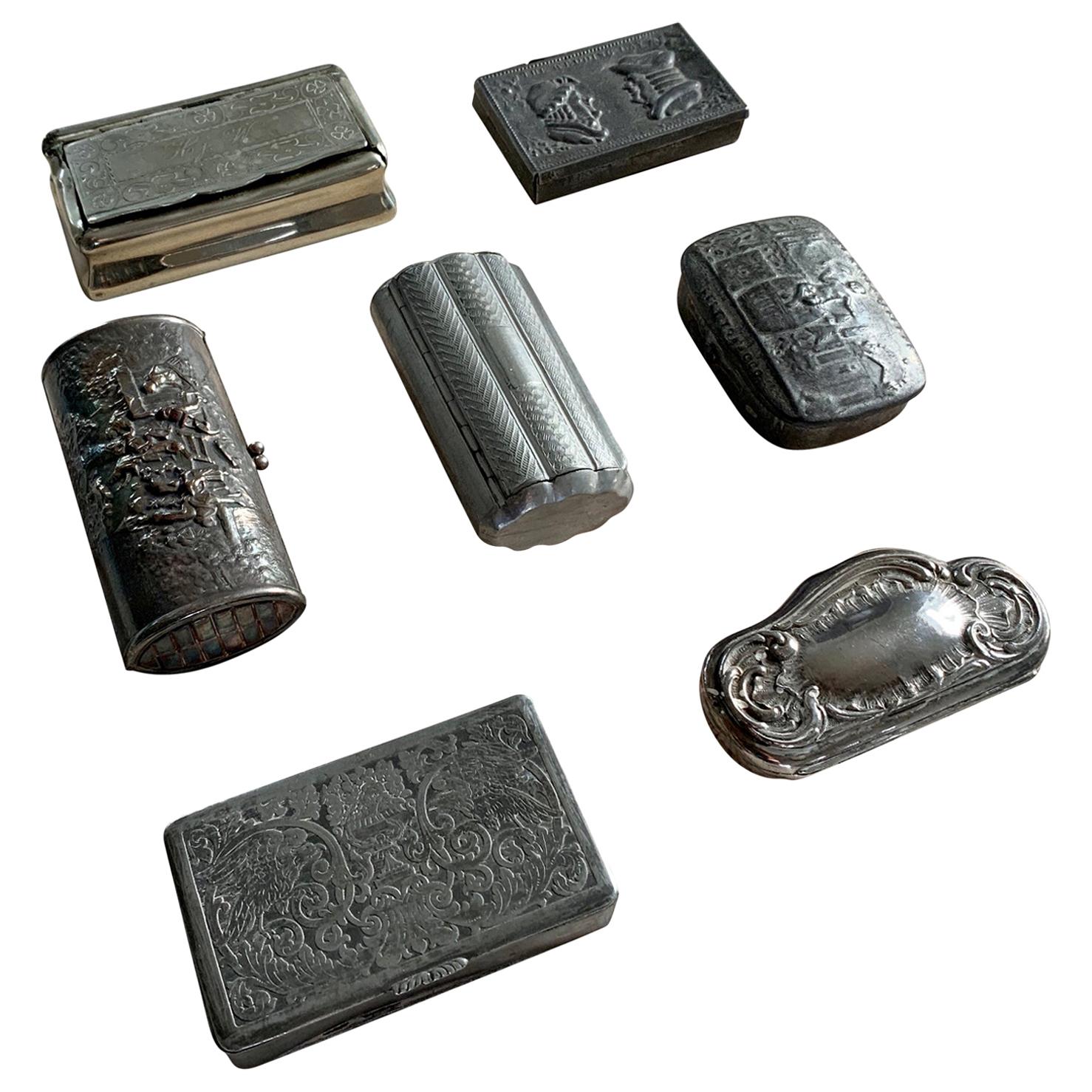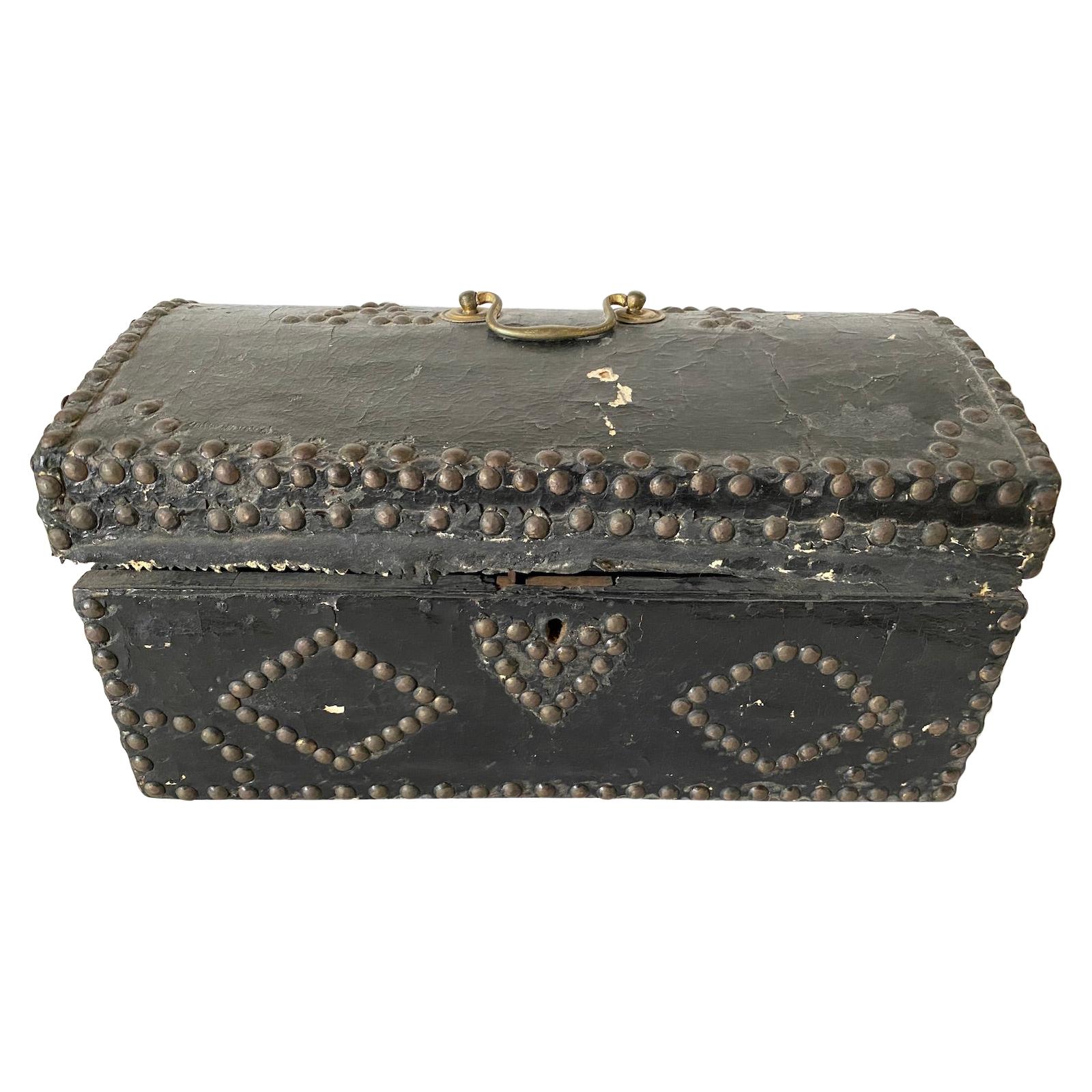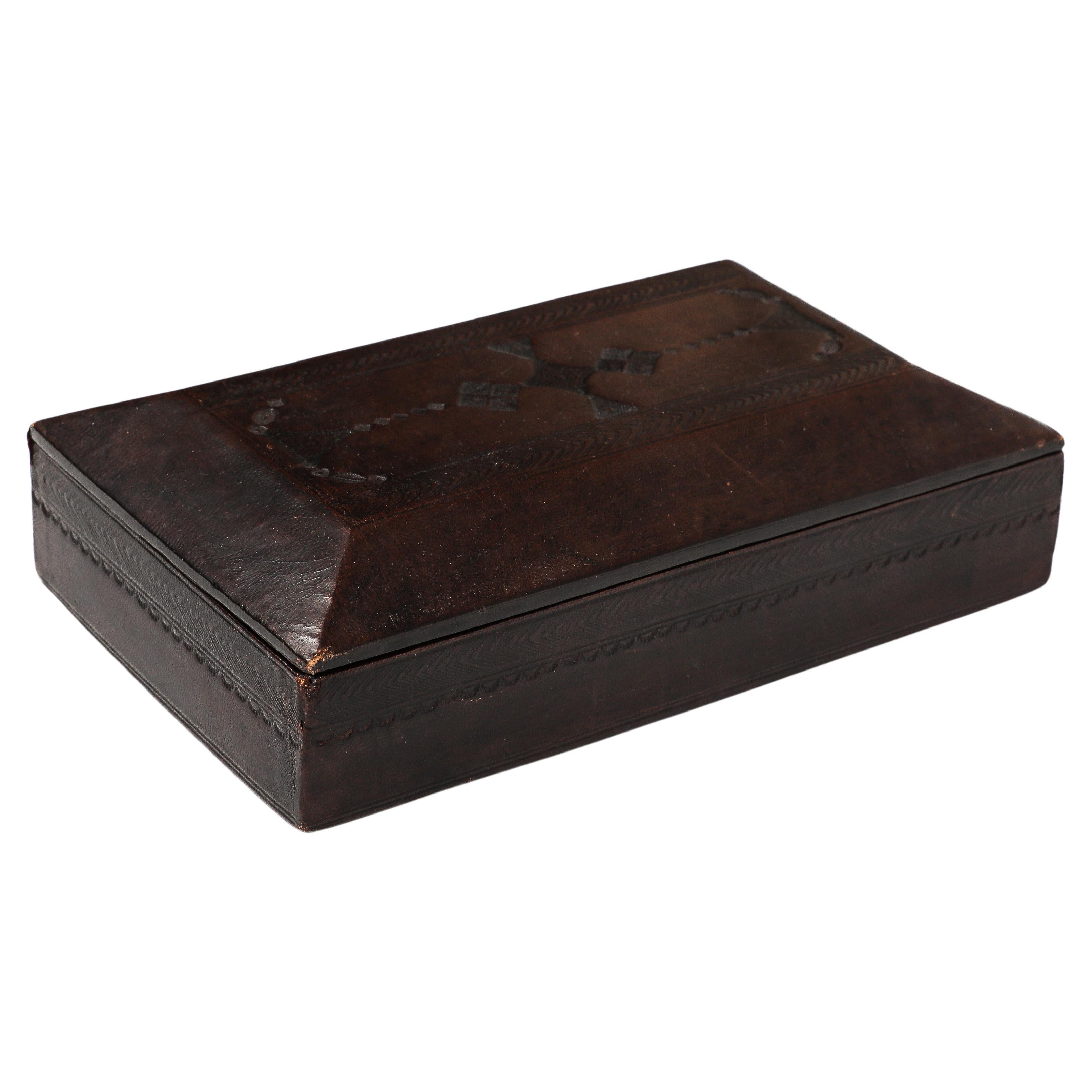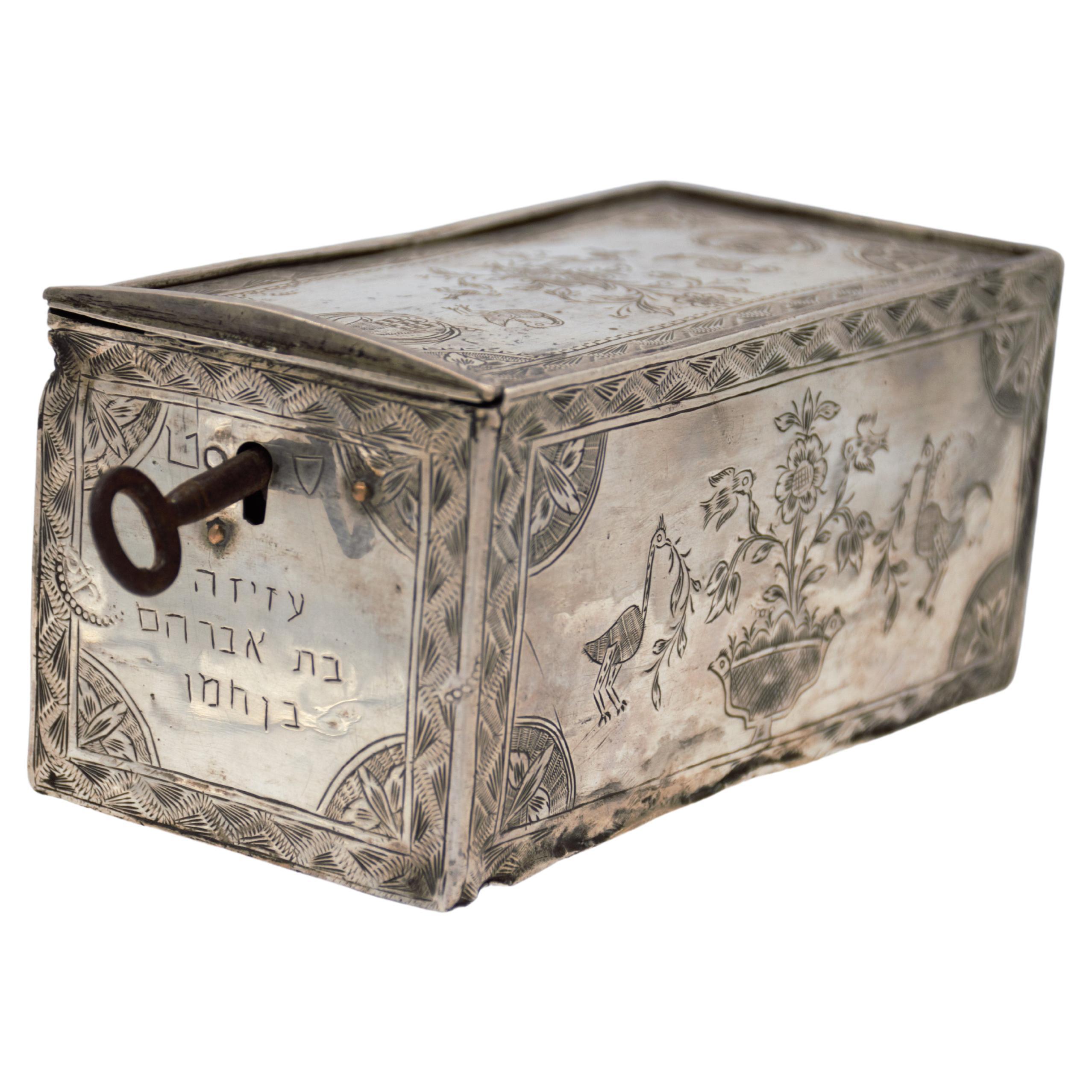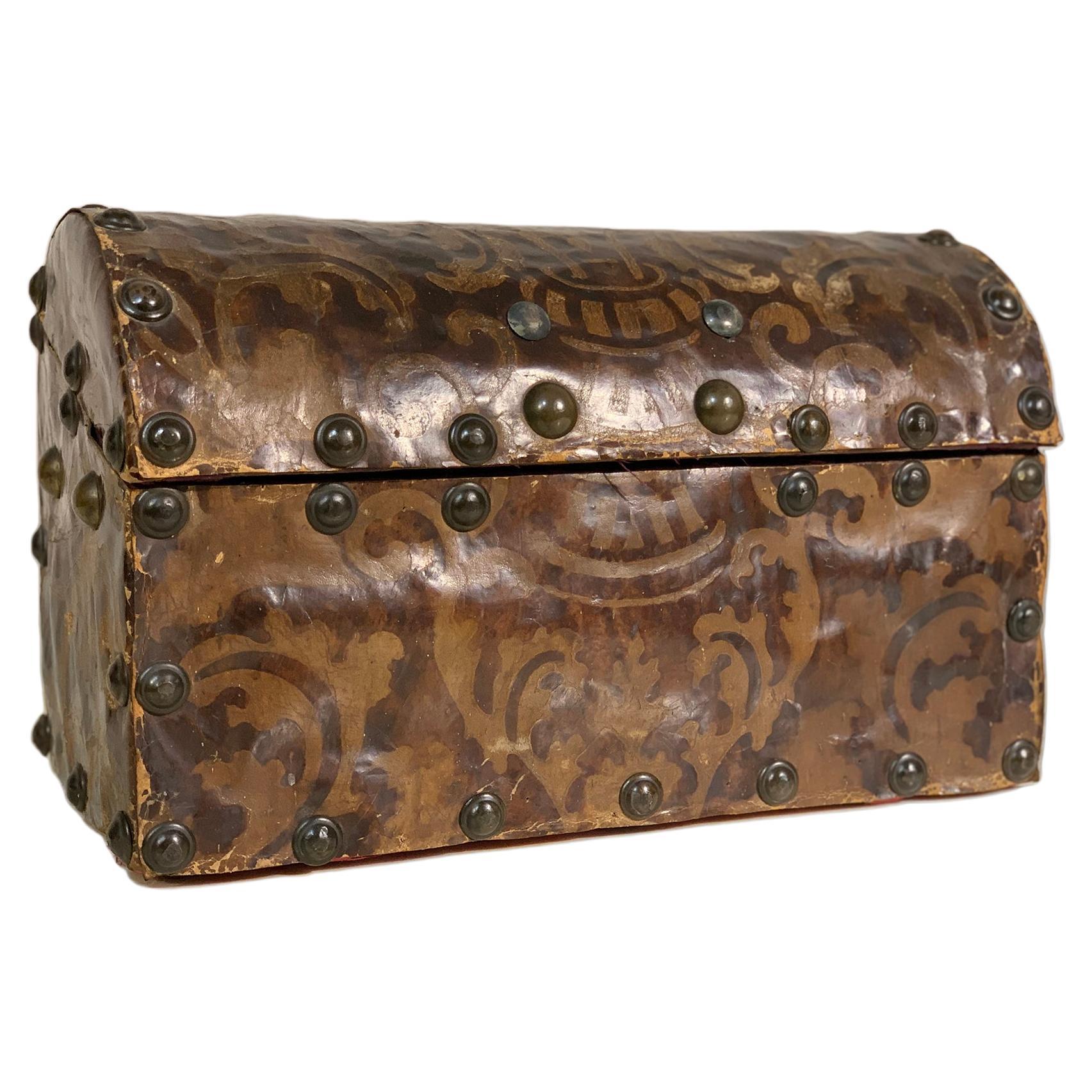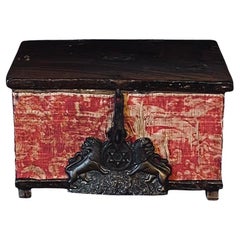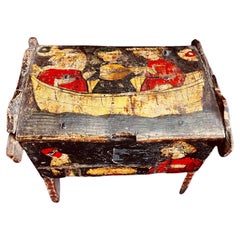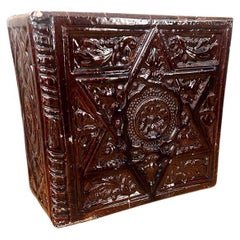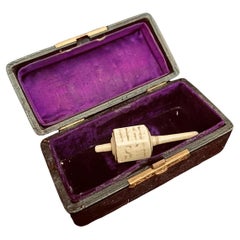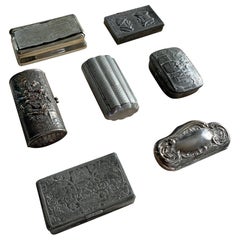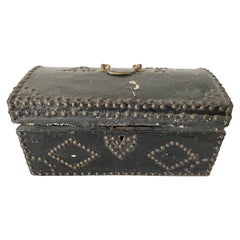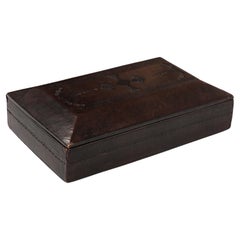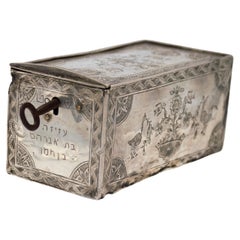Items Similar to Antique Gothic Judaica Box with Kabbalistic Seals and Sacred Texts
Video Loading
Want more images or videos?
Request additional images or videos from the seller
1 of 13
Antique Gothic Judaica Box with Kabbalistic Seals and Sacred Texts
$4,500
£3,393.02
€3,909.98
CA$6,242.72
A$6,994.93
CHF 3,641.13
MX$85,572.21
NOK 46,217.38
SEK 43,651.76
DKK 29,188.82
Shipping
Retrieving quote...The 1stDibs Promise:
Authenticity Guarantee,
Money-Back Guarantee,
24-Hour Cancellation
About the Item
This rare and evocative Medieval Gothic box contains a powerful combination of Salomon’s Kabbalistic seals, a sacred ex libris dedicated to God, and a Star of David inscribed with Hebrew letters representing one of the sacred names of God- either Elohim, Adonai, or HaShem. These names, written with reverence, are traditionally spoken in place of the unpronounceable Tetragrammaton (יהוה), the holiest name of God in Jewish tradition.
The box is crafted in a long, narrow Gothic form, with subtle carved ornamentation. Its top slides open by hand, without any mechanism, adding to its sense of mystery and intentional simplicity- echoing the discreet nature of sacred knowledge.
Inside are several ancient paper fragments, bearing texts and symbols in Hebrew, Latin, and early German. These include mystical seals attributed to King Solomon, often used in Kabbalistic traditions for protection and divine communication. One striking piece displays a Star of David flanked by two angels, with sacred Hebrew letters at its center, evoking powerful spiritual meaning.
Another fragment intriguingly depicts Jesus as a rabbi, surrounded by esoteric symbols and cryptic markings. The exact purpose of these texts remains unknown- they are likely remnants from a lost Gothic manuscript blending Jewish mysticism with Christian iconography.
A rare and spiritually charged object, this box offers a glimpse into medieval esoteric traditions, where Kabbalah, sacred scripture, and hidden wisdom converge. A profound collector’s piece.
- Dimensions:Height: 2.76 in (7 cm)Width: 11.82 in (30 cm)Depth: 4.93 in (12.5 cm)
- Style:Renaissance (Of the Period)
- Materials and Techniques:
- Place of Origin:
- Period:
- Date of Manufacture:Ca 1450
- Condition:Wear consistent with age and use.
- Seller Location:Doha, QA
- Reference Number:1stDibs: LU7451245338862
About the Seller
No Reviews Yet
Vetted Professional Seller
Every seller passes strict standards for authenticity and reliability
Established in 1989
1stDibs seller since 2022
14 sales on 1stDibs
Typical response time: 1 hour
- ShippingRetrieving quote...Shipping from: Mougins, France
- Return Policy
Authenticity Guarantee
In the unlikely event there’s an issue with an item’s authenticity, contact us within 1 year for a full refund. DetailsMoney-Back Guarantee
If your item is not as described, is damaged in transit, or does not arrive, contact us within 7 days for a full refund. Details24-Hour Cancellation
You have a 24-hour grace period in which to reconsider your purchase, with no questions asked.Vetted Professional Sellers
Our world-class sellers must adhere to strict standards for service and quality, maintaining the integrity of our listings.Price-Match Guarantee
If you find that a seller listed the same item for a lower price elsewhere, we’ll match it.Trusted Global Delivery
Our best-in-class carrier network provides specialized shipping options worldwide, including custom delivery.More From This Seller
View AllAntique Extremely Rare Judaica Tzedakah Synagoge Charity Box 16th Century
Located in Doha, QA
This 16th century Tzedakah Charity Box is an incredibly rare and unique museum quality piece. It’s made out of walnut wood and has an original 16th century silk material all over it from outside as well as in the inside, bronze plug in the front and the Star of David with two lions from the left and right side of the Star. There are also two round bronze handles to lift the box from both sides. The Tzedakah Box...
Category
Antique 16th Century Spanish Gothic Historical Memorabilia
Materials
Metal
Antique Rare 15th Century Venetian Casket Former Dr. Albert Figdor Collection
Located in Doha, QA
This exceptional 15th-century Venetian painted casket is a rare example of early decorative art from the late Medieval to early Renaissance period in the Republic of Venice, Italy. H...
Category
Antique 15th Century and Earlier Italian Renaissance Decorative Boxes
Materials
Wood, Paint
Antique 18th Century Rare Judaica Tiled Stove Corner with Star of David
Located in Doha, QA
It’s an incredibly unusual , rare and historical antique 18th century tiled stove or fireplace glazed ceramic corner with Star of David in the midd...
Category
Antique 18th Century Austrian Baroque Architectural Elements
Materials
Ceramic
Antique Rare Judaica Dreidel Germany 19th Century
Located in Doha, QA
An absolutely unique Bone Dreidel originated from Germany in 19th century. It has six sides shaping Star of David. Each side has one or two Yiddish letters on top which refer to an O...
Category
Antique 19th Century German Religious Items
Materials
Bone
Antique Frame French Book Journal Display/Painting 13th-19th Century
Located in Doha, QA
This rare and remarkable piece begins with a backdrop composed of beautifully, handwritten love letters from the 1800s. There are three scrolls made up of additional love letters, sealed with red wax from the 19th century scattered around two antique books. The open book on the left, was written during the time of the 30 Year War, 1618-1648 in France, when the Treaty of Westphalia changed the map of Europe. During this period, the church attempted to begin marriage registrations and within this written relic, there are numerous marriage entries with names and dates. The book is bound by animal hide from the 12th-13th century and when it is unfolded, it becomes a giant piece of parchment filled with faded ink handwriting in mysterious Old French. The closed book on the right is from Louis XIII - XVI era and is bound in antique animal hide parchment from the 12th-13th century. When the animal hide is unfurled, the inside is adorned in faded handwritten ink in peculiar Old French. Inside the journal is elegante handwriting in ink but it is difficult to identify the cryptic content. This journal was possibly written by an unknown noble figure or bishop. Settled below the journals, is an antique, intricate silver feather ink...
Category
Antique 15th Century and Earlier French Gothic Historical Memorabilia
Materials
Gold, Silver
Silver Mezuzah and Torah Pointer Judaica Original Antiquity Art Display 1800s
Located in Doha, QA
This unique item begins with a backdrop of original copper engravings from the early 19th century, depicting the Wailing Wall in Jerusalem, also known as Kotel in Hebrew. In the cent...
Category
Antique 19th Century Austrian Arts and Crafts Religious Items
Materials
Limestone, Sterling Silver
You May Also Like
European Collection of 7 Antique 19th Century Snuff Boxes
Located in Haddonfield, NJ
A curated collection of seven small antique boxes in variation of different metals.
The collection includes:
- One pewter box illustrating a doubl...
Category
Antique Late 19th Century European Victorian Snuff Boxes and Tobacco Boxes
Materials
Metal, Silver Plate, Pewter
19th Century Leather Covered Box with a Domed Lid, Brass Handle and Hinges
Located in Van Nuys, CA
This small box for personal possessions (perhaps papers or letters), is covered in black leather and decorated with borders of brass tacks, including the letters A.T. on its lid, and...
Category
Antique Early 19th Century American Federal Historical Memorabilia
Materials
Brass
Vintage Italian Embossed Lacquered Leather Decorative Box
Located in Chicago, IL
Vintage 20th Century Italian lacquered dark brown leather decorative box. Leather interior. Embossed detail on top and sides.
Category
Late 20th Century Italian Decorative Boxes
Materials
Wood, Lacquer
extremely rare Algerian Judaica silver, jewish Dowry box early 19th century
Located in Tel Aviv - Jaffa, IL
Amazing and scarce JUDAICA object, we have here one of the most touching jewish objects we had for a long time, this small silver dowry box was made in Algeria in the early 19th century, it is all covered with symbols of jewish faith and of couples, the sliding lid has 2 flanking birds with hamsa (protective hand) on each side and a flower vase in the middle.
one side shows two flanking lions with a tree in the middle and the other side shows again two big and two small birds with a flower bowl in the middle, front side has a key hole and next to it there is the Hebrew inscription ס״ט״" which says Siman tov or in English "a good sign" it is taken from the wedding blessing, underneath the lock there is another inscription with the name ״עזיזה בת אברהם בן חמו״ which is the name of the bride, her father and her grandfathers name.
the box is full marked a lot of times with the silversmith mark, every side of the box is marked.
this box was probably ordered by the grooms family to hold the jewelry they are giving to the bride as dowry, this type of objects are rare and there are just a few of them on museum collections.
DOWRY (Heb. נְדֻנְיָה), the property a wife brings to her husband at marriage; the Yiddish equivalent, nadn, is from the same root. The custom of nedunyah became clearly defined and institutionalized only in the talmudic period. In biblical times, mohar (מֹהַר), whereby the groom bought his wife from her father (Gen. 24:53; Ex. 22:15–16; Hos. 3:2), was the accepted practice. It was then customary that the groom give the bride gifts, and that she bring certain property to her husband's home upon marriage: slaves, cattle, real estate, etc. (cf. Gen. 24:59–61; 29; Judg. 1:14ff.; I Kings 9:16). Evidence of the custom of nedunyah is to be found in Tobit (7:14; 8:21) and in the Assuan papyri (Cowley, Aramaic, nos. 15, 18). Gradually, mohar was superseded by the ketubbah custom according to which the husband merely assumed the responsibility of compensation to his wife in case he divorced her: he had to pay her 200 zuzim if she had been a virgin at the time of marriage, and 100 zuzim if a widow or divorcée (see *Ketubbah).
By talmudic times, the institution of nedunyah was prevalent; the father gave a dowry to the bride since the daughter was excluded from paternal inheritance. Fifty zuzim (equivalent to the worth of 180 grams of silver) was the minimum amount a father was obliged to give to his daughter (Ket. 6:5). Parents usually gave much more, according to their social standing. Community funds provided the dowry for an orphan or a very poor girl (ibid.; cf. Sh. Ar., YD 251:8). In case of her father's death, the brothers of a minor girl were obliged to give her the minimum dowry, and the court estimated how much her father would have given her above the minimum dowry. The sum was then taken out of the father's estate and given to the daughter upon majority (Ket. 6:6; 68a–69b). In the absence of such an estimate, each daughter was entitled to receive one-tenth of the value of her father's estate in money, or in valuables (Yad, Ishut, 20:4–7; Sh. Ar., EH 113:4). If the father was unable or unwilling to pay the promised dowry at the betrothal ceremony, the groom could refuse to marry his bride (Ket. 13:5; Ket. 108b–109a). Insistence on exact payment of the promised dowry, however, was frowned upon by later rabbinic authorities (Rema to Sh. Ar., EH 2:1). In certain communities it was customary for the groom's father to make a dowry contribution equal to that of the bride's father (Ket. 102b). The dowry, whether given in real estate, slaves, money, or chattel was recorded in the marriage contract (the ketubbah) and in some instances one-third or one-fifth of the actual value of the dowry was added to the sum mentioned in the ketubbah. Based upon a decree enacted by *Simeon b. Shetah (first century C.E.), the Talmud ruled that the husband and his entire property were liable for compensation as stipulated in the ketubbah, either in case he died (when she collected the sum specified in the ketubbah from the heirs) or in case he divorced his wife (Ket. 82b). For the status of the dowry and the husband's rights and obligations, see below. The rabbinic enactments (Takkanot Shum) by R. Jacob *Tam and by the rabbinic synod of the communities of Speyer, Worms, and Mainz (Germany) stipulated that if a woman died...
Category
Antique Mid-19th Century Algerian Tribal Art
Materials
Silver
17th Century, Italian Wooden Box Coated in Engraved Leather
Located in Firenze, FI
Wooden box lined with leather engraved with damask motifs, studded with convex bronze nails. This casket was used by placing it on the altars of the family chapels to house the candl...
Category
Antique Late 17th Century Italian Decorative Boxes
Materials
Leather, Wood
Danish 19th Century Wooden Folk Art Bible Box "Forget Me Not"
Located in Haddonfield, NJ
Mid-19th century wooden box designed to look like a Bible. Text engraved with monogramme.
The four words in the corners are quite cute and charming:
Danish: "FOR - GLEM - MIG - EJ"...
Category
Antique 19th Century Danish Folk Art Decorative Boxes
Materials
Wood
More Ways To Browse
Antique Letters
Antique Markings
Manuscripts
Antique Manuscript
Ancient Fragment
German Angel
Gothic German
German Wood Angel
Antique Wood Angel
Medieval Manuscripts
German Renaissance Wood Furniture
Medieval Angel
Medieval Seal
15th Century Wood Angel
Church Altar Table
French Wood Religious Statues
Torah Pointer
Antique Bronze Crucifix
